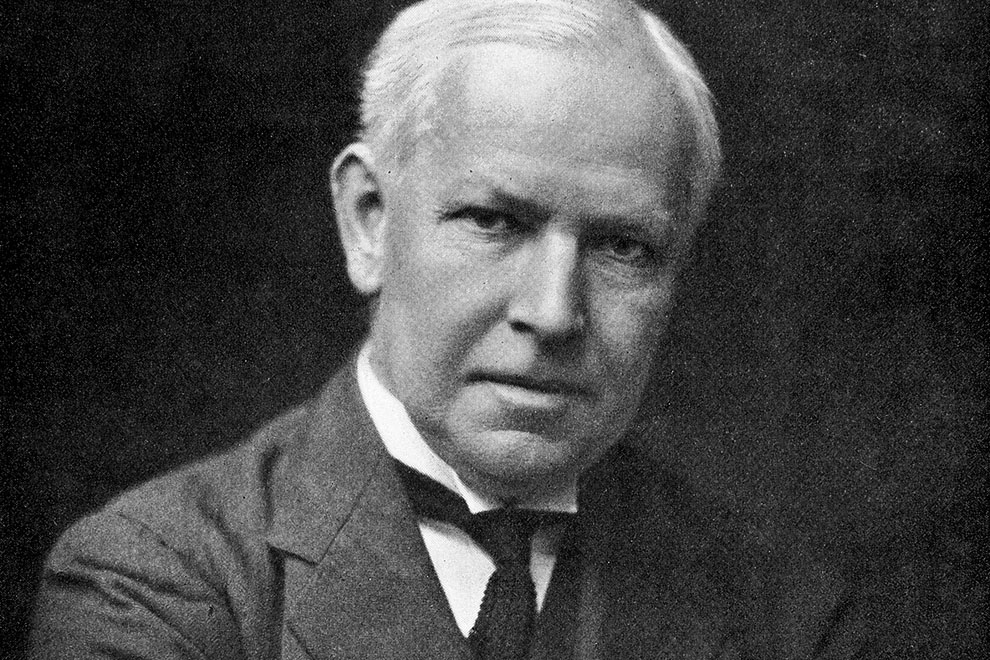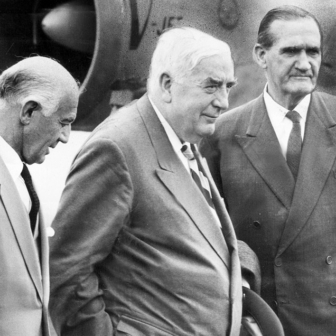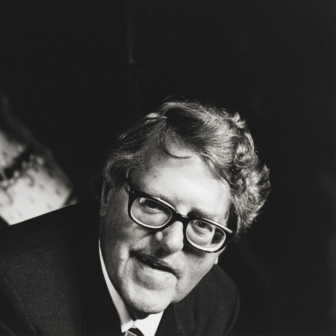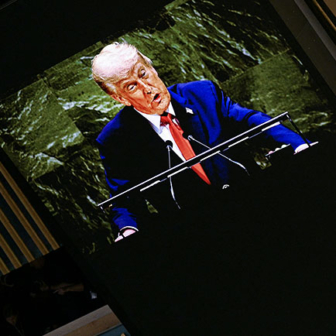The achievements of ancient Egypt so fascinated some people in the first half of the twentieth century that they assigned it a unique role in the spread of world civilisation. They credited Egypt with every innovation from stone building to embalmment, clothing style to personal decoration, and religious deities to philosophy and science. More importantly, they saw Egypt not just as the innovator but as the source from which all the rest of the world learnt these things.
The most prominent campaign to place ancient Egypt at the centre of world history was led by a distinguished Australian-born scientist who turned to writing popular histories on the eve of the first world war. For a quarter-century from 1911, Grafton Elliot Smith, supported by his protégé W.J. Perry and others, argued the Egyptocentric case to a receptive audience, especially in Britain, despite strong opposition from specialists in Egyptology, archaeology and social anthropology, who dismissed his ideas as illusory.
Sir Grafton Elliot Smith FRS (1871–1937) was an academic anatomist, respected teacher, and expert on the mammalian (and especially primate) brain. He was considered the world’s greatest comparative neurologist, and inspired a generation of researchers in anatomy and physical anthropology. He is also credited with transforming the way anatomy was taught in British universities between the first and second world wars. As a professor of anatomy for twenty-eight years (at Cairo, Manchester and University College London) he was also involved in the description and interpretation of human remains found by archaeologists, including fossil hominids and Egyptian mummies.
Unfortunately Elliot Smith also developed the obsessional personal sideline for which he became well known to the public but is remembered with disfavour by archaeologists and historians. Archaeologist Timothy Champion called it “an embarrassing episode in the history of the discipline”; historian Glyn Daniel asked sharply, “Why does the world tolerate this academic rubbish?”
According to Elliot Smith’s theory, which Daniel named “hyperdiffusionism,” innovations in human history occur only once. If the same phenomena were found in different places and times, this represented a process of transmission from the original source – a diffusion from an advanced culture to a primitive one, however geographically distant the societies might be.
To Elliot Smith, ancient Egypt was the source of a vast range of innovations, including agriculture, metalworking and civilisation itself, of traits such as embalmment and building in stone, and of a distinctive pattern of mythology and belief. Cultural elements found in China, Polynesia and South America could be traced back to Egypt. Once asked by W.J. Perry what he thought was happening in the rest of the world while Egypt was laying the basis of its civilising mission, he replied, “Nothing.” Although the details of who did what, and when, were modified (or bypassed) in Elliot Smith’s different writings, the core belief remained.
In a conference held by the Royal Zoological Society in 1972 to mark the centenary of Elliot Smith’s birth, phrases used about him and his work by the biomedical community included “enormous influence,” “first-class scientist,” “worldwide reputation,” “a great pioneer,” “the simplicity of greatness,” as well as “immensely kind.” Those from archaeology and anthropology were markedly different: “very extreme and rigid,” “extravagant,” “notorious,” “delusion,” “extraordinarily doctrinal,” “bizarre.”
Why did a distinguished scientist developed such extreme ideas? Why did those ideas attract enthusiastic followers despite consistent criticism from archaeologists and anthropologists?
Elliot Smith was born to an Australian mother and a father of British origin in the NSW town of Grafton. He went to school at the elite Sydney Boys High School after his father took up a post as a school principal in Sydney. After studying at the Sydney University medical school and undertaking a year of hospital clinical work, he was appointed a university demonstrator in anatomy. Alongside his doctoral thesis on the brain of the non-placental mammal (for which he received a University Gold Medal) he completed a dozen papers on neurological topics. Awarded a travel scholarship to Britain at the age of twenty-five, he enrolled as a research student at the University of Cambridge and within three years had been elected to a Research Fellowship.
In 1900, Elliot Smith took up a professorship in anatomy at the Government Medical School in Cairo, continuing his research there and in Britain, to which he was able to return in university vacations. According to his Royal Society obituary, Cairo offered “an almost unlimited provision of recent brain material” to the young researcher. By 1907, aged just thirty-six, his reputation in neurological research and the evolution of the mammalian brain was sufficient for him to be elected a Fellow of the Royal Society. (He would be vice-president six years later.) In 1909 he returned permanently to Britain as professor of anatomy at the University of Manchester.
During his nine years in Egypt, having initially “quite resisted the temptation to dabble in Egyptology,” he found links to his brain studies within archaeological material, and went on to publish pioneering work in the techniques of mummification. His examination of Egyptian skeletal material from a wide range of periods gave him a basis for classifying this material into “racial” groups and suggesting a sequence of population movements.
In Manchester he maintained his studies of the evolution of the mammalian brain and his reports on mummification. During the war, as a member of Britain’s General Medical Council, he collaborated with psychologists in the study of shell shock, co-authoring a monograph on Shell Shock and Its Lessons (1917),which argued for the humane medical recognition and treatment of the condition. Working with psychologists also helped him consider further his specifically biological approach to the brain, and he remained highly critical of Freudian and other trends as applied in psychology. One of his last (co-authored) books was The Neural Basis of Thought.
Moving to University College London in 1919 Elliot Smith secured funding to transform anatomy teaching – in a new anatomy school incorporating ancient Egyptian decorative and architectural elements – while sponsoring, inspiring and continuing research that extended the discipline into human biology and what would later be called palaeoanthropology and physical anthropology. His knighthood in 1934 recognised his transformational role in anatomical teaching and research.
Elliot Smith’s academic rise had been dramatic. As a colleague observed, “In Cambridge he was a neuro-anatomist pure and simple: in Cairo he was forced to be other things.” Archaeologists turned to Elliot Smith as the man on the spot teaching human anatomy. They wanted analysis, reports, and interpretation of the burials coming from current excavations, notably those from George Andrew Reisner’s work at sites in Nubia, which were scheduled to be flooded by the waters of the first Aswan Dam. Elliot Smith was therefore involved for nine years in teaching, in the maintenance of his own research on the brain, and in meeting the demands to apply his skills to remains from ancient Egypt. This he did, although the size of the task was such that he was never able to publish the results of all his studies; there were reported to be 20,000 bodies recovered during the Nubian work alone.
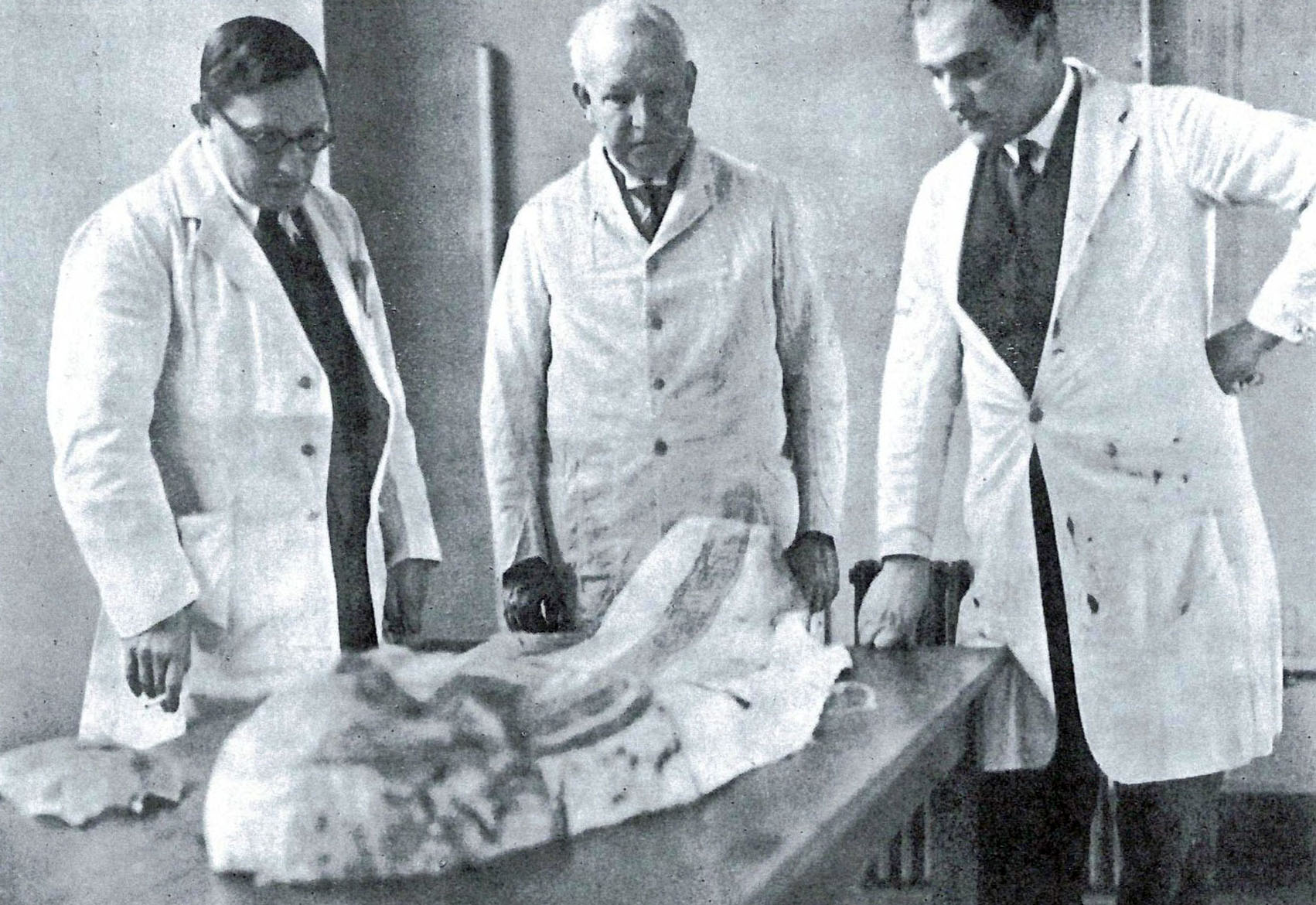
Grafton Elliot Smith (centre) examining a mummy at University College London in 1930 with colleagues H.A. Harris and W.R. Dawson. From Sir Grafton Elliot Smith: A Biographical Record By His Colleagues, edited by Warren R. Dawson (Jonathan Cape, 1938).
As he made detailed observations of the nature and processes of mummification, he began developing views about the races of ancient Egypt. From the late nineteenth century until the 1930s every specialist had his or her own preferred classificatory scheme for present and past races. In Elliot Smith’s model, ancient Egyptians were not black (or Negroid), although there was some admixture in Nubia. He believed he had found a sequence involving population movement of a brown-skinned Mediterranean race, as well as Armenoid and (European) Nordic races. In his general survey books on human evolution he expanded in more detail on his assumptions about racial difference, while emphasising at times that race and culture are not the same and need not correlate.
In his book The Ancient Egyptians and Their Influence Upon the Civilization of Europe, published in London and New York in 1911, he made a committed argument for the idea of cultural diffusion from Egypt. As his ideas developed (there was a revised edition in 1923) Egypt’s influence went further afield: to India, China, Japan, the Pacific and Australia, and even the Americas. “Ideas and culture do not spread among uncivilized people except by the settlement amongst them of those who practice the new arts and hold the new beliefs,” he wrote. “But these settlers need not be great in numbers.” The transmission took place through ships of Egyptian design, which ventured as far as Madagascar, Mozambique, Burma, Indonesia and Indochina, with influences beyond that into the Pacific.
By the point at which he made this argument, late in the book, his narrative had gone from drawing on his own experience with ancient Egyptian burials to a specific hypothesis: that European prehistoric stone building owed its origins to ancient Egypt – a view still considered possible by others at that time, before radiocarbon dating confirmed otherwise. But then, without presenting substantive evidence, he made a major leap to a broader view of Egypt’s reach throughout the world.
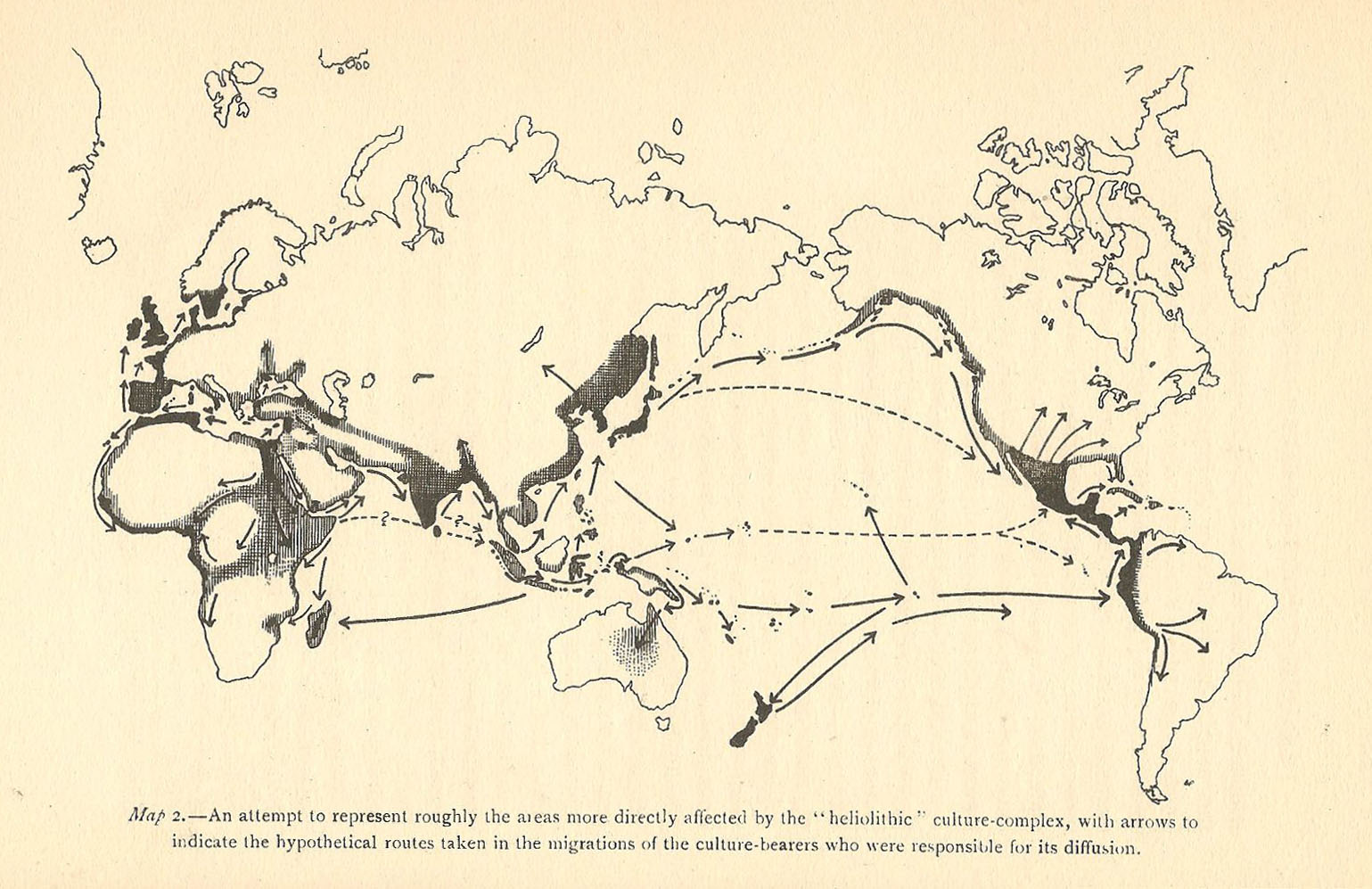
Grafton Elliot Smith’s worldwide diffusion of culture from Egypt. From the second edition of his book, The Migrations of Culture (1929).
Despite changing emphases, looseness of detail and inconsistencies in argument, the essential core of Elliot Smith’s argument remained the same for over a quarter of a century. His views did evolve (or rather deepen in their application and conviction), and there were inevitably discrepancies and contradictions.
Egyptian sea-going vessels were involved, as later were those of Phoenicians, but other “ancient mariners” spread the complex of beliefs, associated practices and material innovations further. Indian and Chinese and American civilisations owed their existence to this diffusion. The innovations originally sourced from Egypt were spread to Australia, to the Pacific Islands and thence to the west coast of South and North America, although there was also cultural transmission from northeast Asia into the Americas.
Elliot Smith soon found support for his approach from individuals, including W.J. Perry and the renowned psychologist and anthropologist W.H.R. Rivers, who would stay his allies. Thus encouraged, the distinguished Manchester anatomy professor and Fellow of the Royal Society took to the hustings. He presented his arguments with increasing conviction (and to substantial criticism) at annual meetings of the British Association for the Advancement of Science from 1912 on.
Archaeologists and anthropologists were forced to engage with his ideas, even if they considered Elliott Smith an outsider. To the annoyance of social anthropologists, he was invited to compile the entry on “Anthropology” in the 1921 edition of the Encyclopædia Britannica, which allowed him to present his marginal ideas as if mainstream. Ironically, his move to University College London in 1919 brought him to the very centre of scientific archaeology of Egypt, where W.M. (later Sir) Flinders Petrie was Professor of Egyptian Archaeology from 1892 to 1933. They maintained their distance.
The 1914 meeting of the British Association was held in Elliot Smith’s native country, Australia. He planned to talk of the spread of mummification from Egypt, and before the talk he was shown an embalmed male of the nineteenth century from Darnley Island in the Torres Strait between New Guinea and the Australian mainland. This exhibited evidence of posthumous handling, which Elliot Smith immediately linked to Egyptian mummification. His talk announced the newfound evidence for ancient Egypt’s direct influence on the traditions of the Torres Strait. Arguments by the anthropologist who had studied the region, A.C. Haddon, had no impact.
The Torres Strait “mummy” had important effects on Elliot Smith’s thinking. It confirmed his belief in distant influence, for he considered embalming could only have been invented once, and that in ancient Egypt. Every example of embalming practices, from the Mediterranean to East Asia, the Pacific Islands to South America, had therefore spread from an Egyptian source. But there were specific techniques in the Torres Strait body that were only introduced in Egypt after the Twenty-second Dynasty. From this alone, Elliot Smith concluded that the major spread of Egyptian culture that he had been preaching, eastwards to Asia and on to the Pacific and the Americas, had to be dated to after the ninth century BCE.
This weakened an already weak case. It might be difficult to prove or disprove the influence of early pharaonic Egypt on non-literate communities of European prehistory. But the period after the ninth century BCE was an era of widespread literacy and increasingly well-studied documentation from civilisations of Asia and beyond, quite apart from the wealth of material from Egypt itself on administration, commerce and foreign relations. And there are no records of expeditions that could have shipped Egyptian culture to the east. Later, in The Diffusion of Culture (1933), Elliot Smith would compare the fast spread of his Egyptian cultural items with the rapid spread of Islam. But there was a major difference: numerous historical records show what did happen in early Islam; historical records equally show what did not happen in first-millennium BCE Middle East, India and China.
Elliot Smith presented an ambitious programmatic public statement of his revised views in The Migrations of Early Culture, published in 1915and reissued without change in 1929. The subtitle was A study of the significance of the geographical distribution of the practice of mummification as evidence of the migrations of peoples and the spread of certain customs and beliefs. The style is pugnacious, unapologetic and highly critical of those who did not accept his views. Yet the evidence presented is minimal and the data only suggestive. A respected scientist like Elliot Smith would never have allowed such statements in the field of brain studies from a student or a colleague, or indeed from himself.
As if in response to the critics he had faced at British Association meetings, Elliot Smith attacked traditional scholarship head-on, with “an appeal to ethnologists to recognise the error of their ways and repent.” He wanted “to force scientific men to recognise and admit that in former ages knowledge and culture spread in much the same way as they are known to be diffused today. The only difference is that the pace of migration has become accelerated.”
The idea of innovation always spreading from “higher” to “lower” cultures could be seen as reflecting Elliot Smith’s own background and career. France’s creation of a Government Medical School in Cairo in 1827 was designed to spread Western medical ideas to Egypt. When the new British administrators took it over in 1893, they sought to improve its teaching with initiatives that included Elliot Smith’s appointment. He would be able to witness the influence and diffusion of external culture during its most influential period in Egypt.
Elliot Smith’s own background was even more dramatic a display of cultural change arriving from outside. The country town of Grafton, where Elliot Smith was born in 1871, had introduced into inland Australia a new culture that was fundamentally British. Forty years earlier this area had been the exclusive territory of nomadic hunter-gatherers of the Bundjalung and Gumbainggir peoples. There can be few examples more extreme than nineteenth-century inland Australia in showing cultural change through external introduction rather than through local development.
The identification of Australia with Britain was most emphatically demonstrated in the Great War, when graziers’ sons from Australia’s rural outback in 1915 volunteered to take on the Ottoman Empire in the Dardanelles in the name of a dispute between Britain and Germany’s ally. When Elliot Smith travelled to England, 17,000 kilometres from his Australian home, he encountered a world in which much was familiar.
All this suggests that Elliot Smith, not alone among “colonials” coming to mother England at the time, was “more British than the British” in his enthusiasm for the imperial model. In the years when Elliot Smith developed and presented his diffusionist paradigm (roughly 1911–34) European empires were at their height, with Britain’s dominions and colonies covering a quarter of the world’s land surface. The world was one of cultural diffusion (and local adaptation of that culture) and the imperial model, in its ideological underpinnings, was one that preached the benefits of enforced modernisation over indigenous development.
There is also the question of personality. The opposition that greeted Elliot Smith’s diffusionist theories from the start would have discouraged many people, especially those who considered themselves within rather than opposed to the world of academic research. The greater the opposition, though, the greater his enthusiasm. In Culture: The Diffusion Controversy (1928) he went as far as adopting the label used to criticise him when he referred to “we of the Diffusionist School.” This must in part reflect his natural personality but also the unbroken success of his career. His meteoric rise in the world of science was not even stayed by war; he continued his teaching and research uninterrupted by the Great War except to add further research on shell shock to his panoply. It seems that few had ever said anything but “yes” to the bright young scientist. And while some British scientists in the early twentieth century might be awed by the stratification of class and background, for him as for many other colonials, family background and perceived class provided neither interest nor inhibition.
Elliot Smith was helped by his forceful personality alongside his “charm and imposing presence.” He was a confident and articulate public speaker, though the neat order he imposed on world history was not reflected in his chaotic office. He was an engaging and readable author and publishers continued to pursue him for survey volumes. Some were on more specific parts of his model and some general surveys, culminating in Human History (1930). The specific claims grew. Opposition to his ideas on human history from the established scholars in archaeology, history and anthropology had no effect in reducing his enthusiasm to advance his ideas: “preaching his gospel,” as he would call it.
Why did Elliot Smith’s views attract such a popular following, especially in Britain, in the interwar years? This was a period of growing scientific research into the human past punctuated by grand discoveries, like Tutankhamen’s tomb (1922–32) and the Royal City of Ur (1922–34). But it was also an era in which people were searching for grand but non-religious theories in a world that had produced the tragedy and illogicality of the Great War, with a growing sense that the era of European empires might not be as permanent or stable as had been assumed.
The ideology of empire may have inspired Elliot Smith’s model of diffusion of culture; it certainly inspired his British readers. The attraction of diffusionism to a reading public is that it suggested all human progress was based on the blessings that derived and spread from an advanced civilisation. Such a perspective appeared to confirm the positive benefits of the colonial model, but also reassured those concerned with the decline of one major colonial empire (that of Germany) and the question of the long-term future of Britain’s largest colony, India, whose original civilisation was, according to Elliot Smith, derived from Egypt.
Alongside the political appeal of a diffusionist model was the attraction of the exotic and mysterious. Prewar confidence in national destiny may have been dented, and prewar certainties in religious faith were certainly changing among many of the “reading classes” in Britain. Fundamentalist Christianity in Britain may have fought a losing battle against science by the end of the nineteenth century, while the interwar years saw an openness to new scientific ideas. With Elliot Smith, here was a scientist whose views were appealing (even if not to those whose scientific field was archaeology or anthropology). They combined apparent rationalism – an explanation of human history outside of teleological religious models – with the frisson of remaining mystery. In the troubled ideological conflicts and social challenges of the 1920s and 1930s in Britain, we can also see the appeal of the rebel scientist, the establishment man who is prepared to take on the rest of the establishment over what he sees as a truth being hidden from view by conventional thinkers.
Reviews in The Times Literary Supplement of Elliot Smith’s earlier popular books on history were respectful and complimentary while not necessarily endorsing his conclusions. But by 1930 a less obsequious tone had entered: its review of Human History was assigned to a contemporary opponent of Elliot Smith’s views whose review concluded that the reader “is bound to welcome so masterly a synthesis, even if his immediate reaction is to try to pull it to pieces.”
The Elliot Smith story is unusual. Most writers who advance a theory from outside the relevant discipline at odds with the current range of scholarly interpretations are dismissed as pseudoscientists and ignored in the literature and scholarly debates. Occasionally an exasperated academic takes a major writer to task. But generally the proponents of these ideas are not seen as part of scholarly discourse. Specialists did find it necessary to take seriously and combat Elliot Smith’s ideas because of his scientific distinction in anatomy, as well as the popular following his ideas achieved. He was “one of us,” to be criticised, rather than a voice from the outer fringes to be ignored.
Towards the end of Elliot Smith’s life, the changing politics of 1930s Europe presented challenges to the confidence with which scientists (including Elliot Smith himself) had incorporated racial models in the narrative of past and present human societies, including those of the ancient world. In 1934 he was among the anatomists and physical anthropologists who began to see and resist what could happen when scholarly discourse and popular Western books about the supposedly lesser races were transformed into political action by Nazi ideologues.
Elliot Smith died in 1937. His heritage was a theory that attributed historical change to the inventions by, and spread from, one ancient society and people: a heliolithic Egyptocentric diffusion that created a world culture and underlay the growth of civilisation. Consider some of his statements in Ancient Egyptians:
Egypt was not only the inventor of civilization, but for several millennia afterwards it continued to be the inspiration of the progressive development of her original heritage to the world… laying the foundations of civilization and… moulding the history of the world… [I]t is idle to refuse the due recognition of the claim made for Egypt of having forged the instruments that raised civilization out of the slough of the Stone Age… Thus Egypt brought her influence to bear… not by the violent imposition of an alien culture… but by raising the members of her own family group of peoples to a higher plane of knowledge and skill by inoculating them with the germs of her own culture.
If we change the timeframe to the late nineteenth century – the decades of Elliot Smith’s youth in Australia – and substitute “the British Empire” for “Egypt,” we are in a territory of more familiar rhetoric. Such claims for the past sound less anomalous in the setting that generated, supported and listened to the extreme diffusionism of Grafton Elliot Smith. •
This is an edited extract from Robin Derricourt’s Antiquity Imagined: The Remarkable Legacy of Egypt and the Ancient Near East, published this month by I.B. Tauris.
